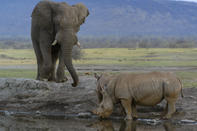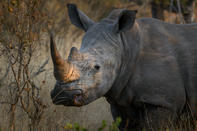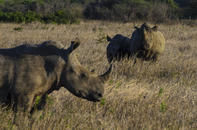Sought After
White rhino are one of the largest land mammals on earth and as such enjoy a position amongst the ‘Big 5’ – historically those animals most dangerous to hunt but now are the most sought after by tourists.

Ceratotherium Simum

1.8 m shoulder
Weight
Male: up to 2400 kg
Female: ave 1600 kg
Lifespan
About 40 years
Habitat
Flat undulating terrain with grasslands to feed, thick cover to rest up and water to drink and wallow.
Gestation
16 months
No. of young
1
Food
Selective grazer (species), prefers short fresh growth
Predators
Calves preyed on by lion and hyena; humans
Did You Know?

White rhinos differ from black rhinos in several ways. Black rhino are smaller than white rhino overall. They have shorter heads that are carried higher up on their shoulders than the white rhino to accommodate their browsing (not grazing) habits.
The black rhino has a prehensile hook-shaped lip to help it secure leaves and twigs (compared to the wide mouth that the white rhino uses to graze). Twigs are cropped at a 45 degree angle due to the shape of the black rhino’s teeth and this angle is clearly identifiable in the twigs in their droppings.
The ears of the black rhino are smaller and rounder and it lacks the large nuchal hump of the white rhino over the shoulders. The black rhino is one of Africa’s top 10 most endangered animals.
By Megan Emmett